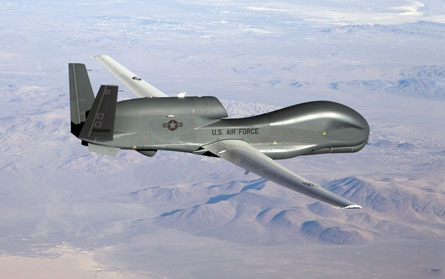The US Navy is cleared to start buying the Northrop Grumman RQ-4N Global Hawk after government auditors dismissed an appeal from Lockheed Martin.
The decision by the US Government Accountability Office means Northrop secures the Broad Area Maritime Surveillance (BAMS) contract for the $2.3 billion development phase and opens the door for a production phase worth up to $4 billion.
Meanwhile, potential foreign buyers for the naval Global Hawk, including Australia, Canada, Japan and Singapore, could ensure active production for the high-altitude unmanned aircraft vehicle far into the next decade.

The impact of the GAO protest review on the programme's schedule has not been determined, according to Capt Bob Dishman, programme manager of the USN's persistent maritime UAV programme, which oversees BAMS.
As of contract award on 22 April, Dishman had expected Northrop to fly the first RQ-4N in 2011 and deploy the first of five planned units in 2014 or 2015.
"We are in the process of addressing programme impacts as a result of the protest to ensure the BAMS UAV is delivered as expeditiously as possible to the fleet," Dishman says. Naval Air Systems Command has declined requests for interviews.
The GAO declines to explain why it rejected the appeal from Lockheed, which submitted one of three bids for the contract. A redacted decision statement could be released before the end of the month, the GAO says.
Lockheed, which offered the Mariner version of the General Atomics Predator B, claims its bid would have saved the government $5 billion over the life of the programme compared with the RQ-4N.
"We look forward to further reviewing the documents to better understand the evaluation," Lockheed says.
The third bidder, a Boeing/Gulfstream team offering an optionally manned G550 with a Raytheon mission system, did not submit an appeal.
The contract is a huge win for the Northrop team. Unlike the US Air Force version of the RQ-4, which employs a Raytheon sensor suite, the naval version will be equipped with a new Northrop radar called the multifunction active sensor.
According to Northrop, the GAO decision "reaffirms that Northrop Grumman's offering was selected as the best value determination in a fair and open competition", the company says.
BAMS is among three new aircraft types expected to replace hundreds of ageing Lockheed P-3C and EP-3E maritime surveillance aircraft.
Boeing has been selected to deliver 108 P-8A Poseidons, a new military variant of the 737-800ERX, for the anti-submarine warfare role. The P-8A and the Airbus A320 also may compete for the forthcoming EPX contract to replace the EP-3E electronic intelligence fleet.
Source: Flight International
















